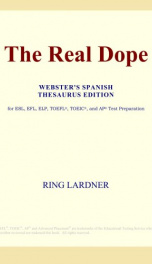Lardner Ring

Ringgold Wilmer Lardner (March 6, 1885 – September 25, 1933) was an American sports columnist and short story writer best known for his satirical takes on the sports world, marriage, and the theatre. Born in Niles, Michigan, Ring Lardner was the son of wealthy parents Henry and Lena Phillips Lardner. He was the youngest of nine children. Lardner's name came from a cousin with the exact same name. The cousin, in turn had been named by Lardner's uncle, Rear Admiral James L. Lardner, who had decided to name his son after a friend, Rear Admiral Cadwalader Ringgold, who was from a distinguished military family. Lardner never liked his given name and shortened it. Lardner was married to Ellis Abbott of Goshen, Indiana in 1911. They had four sons, John, James, Ring Jr., and David. John was a newspaperman, sports columnist and magazine writer. James, also a newspaperman, was killed in the Spanish Civil War fighting with the International Brigades. Ring Lardner, Jr., a screenwriter who was blacklisted after the Second World War as one of the Hollywood Ten, screenwriters who were incarcerated for contempt of Congress after refusing to answer questions posed by the House Un-American Activities Committee (HUAC). He won two Academy Awards for his screenplays—one before (for Woman of the Year in 1942) and one after (for M*A*S*H in 1970) his imprisonment and blacklisting.[1] His book, The Lardners, My Family Remembered (ISBN 0060125179), is a reliable source of Lardner information. David worked for The New Yorker as a general reporter and war correspondent before he was killed by a landmine near Aachen, Germany in October 1944, less than one month after his arrival to the European Theater of war. Lardner was a grand uncle to 1993 Pulitzer Prize winner George Lardner, Jr., a journalist at The Washington Post since 1963.[2] In 1916 Lardner published his first successful book, You Know Me Al, which was written in the form of letters (an epistolary), written by "Jack Keefe," a bush league baseball player, to a friend back home. The letters made heavy use of the fictional author's idiosyncratic vernacular. It had initially been published as six separate, but inter-related short stories in The Saturday Evening Post, leading some to classify the book as a collection of short stories; others have classified it as a novel. Like most of Lardner's stories, You Know Me Al employed satire, in this case to show the stupidity and avarice of a certain type of athlete. "Ring Lardner thought of himself as primarily a sports columnist whose stuff wasn't destined to last, and he held to that absurd belief even after his first masterpiece, You Know Me Al, was published in 1916 and earned the awed appreciation of Virginia Woolf, among other very serious, unfunny people", wrote Andrew Ferguson, who named it, in a Wall Street Journal article, one of the top five pieces of American humor writing.[3] Lardner went on to write such well-known stories as Haircut, Some Like Them Cold, The Golden Honeymoon, Alibi Ike, and A Day in the Life of Conrad Green. He also continued to write follow-up stories to You Know Me Al, with the hero of that book, the headstrong but gullible Jack Keefe, experiencing various ups and downs in his major league career and in his personal life. Private Keefe's World War I letters home to his friend Al were collected in Treat 'Em Rough. Lardner also had a lifelong fascination with the theatre, although his only success was June Moon, a comedy co-written with Broadway veteran George S. Kaufman. He did write a series of brief nonsense plays which poked fun at the conventions of the theatre using zany, offbeat humor and outrageous, impossible stage directions, such as "The curtain is lowered for seven days to denote the lapse of a week." Lardner was a close friend of F. Scott Fitzgerald and other writers of the Jazz Age. He was published by Maxwell Perkins, who also served as Fitzgerald's editor. To create his first book of short stories Lardner had to get copies from the magazines he'd sold them to—he held his own short stories in light regard and did not save copies. He was in some respects the model for the tragic character Abe North in Fitzgerald's last completed novel, Tender Is the Night . With the exception of You Know Me Al, which was initially written and published as six separate stories, Lardner never wrote a novel, but is considered by many to be one of America's best writers of the short story. Lardner was also a well-known sports columnist, who began his career as a teenager with the South Bend Tribune. Soon after, he took a position with the rival South Bend Times, the first of many professional switches. In 1907, Lardner moved to Chicago, where he joined the Inter-Ocean, considered the worst newspaper in the city. Within the space of a year, he moved up to the Chicago Examiner, then to the Tribune.[4] Two years later, Lardner was in St. Louis , writing the humorous baseball column "Pullman Pastimes" for Taylor Spink and the Sporting News; some of this work was the genesis for "You Know Me Al." Within three months, he was an employee of the Boston American. Lardner returned to the Chicago Tribune in 1913, which became the home paper for his syndicated "In the Wake of the News" column (started by Hugh Keough, who died in 1912); it appeared in more than 100 newspapers, and still runs in the Tribune. Sarah Bembrey has written about a singular event in Lardner's sportswriting experience: "In 1919 something happened that changed his way of reporting about sports and changed his love for baseball. This was the Black Sox scandal when the Chicago White Sox sold out the World Series to the Cincinnati Reds. Ring was exceptionally close to the White Sox and felt he was betrayed by the team. After the scandal, Ring always wrote about sports as if there were some kink to the outcome."[4] Walter Allen stated “It is like Lardner perfectly feeds a specific American trait into every character of every story he ever wrote.” In the 1988 movie about the Black Sox, Eight Men Out, writer-director John Sayles portrayed Lardner as one of the clear-eyed observers who were not taken in by the conspiracy. In one scene, Sayles strolls through the White Sox train, singing a parody of the song "I'm Forever Blowing Bubbles," changed to "I'm Forever Blowing Ballgames."[5] Lardner's last baseball writing was Lose With a Smile in 1933. Lardner influenced Ernest Hemingway, who sometimes wrote articles for his high school newspaper under the pseudonym Ring Lardner, Jr.[6] He died Sept. 25, 1933 at age 48 in East Hampton, New York, of complications from tuberculosis.
do you like this author?
What readers are saying
What do you think? Write your own comment on this book!
write a commentWhat readers are saying
What do you think? Write your own comment on this author!
write a commentBook list

Treat 'em RoughLetters from Jack the Kaiser Killer
Series:
Unknown
Year:
Unknown
Raiting:
3/5
Show more
add to favoritesadd In favorites

The Real Dope
Series:
Unknown
Year:
Unknown
Raiting:
4.5/5
Webster's edition of this classic is organized to expose the reader to a maximum number of synonyms and antonyms for difficult and often ambiguous English words that are encountered in other works of literature, conversation, or academic examinations. Extremely rare or idiosyncratic words and expressions are given lower priority in the notes compared to words which are ¿difficult, and often encountered¿ in examinations. Rather than supply a single synonym, many are provided for a variety of meanings, allowing readers to better grasp the ambiguity of the English language, and avoid using the notes as a pure crutch. Having the reader decipher a word's meaning within context serves to improve vocabulary retention and understanding. Each page covers words not already highlighted on previous pages. If a difficult word is not noted on a page, chances are that it has been highlighted on a previous page. A more complete thesaurus is supplied at the end of the book; synonyms and antonyms are extracted from Webster's Online Dictionary. PSAT¿ is a registered trademark of the College Entrance Examination Board and the National Merit Scholarship Corporation neither of which sponsors or endorses this book; SAT¿ is a registered trademark of the College Board which neither sponsors nor endorses this book; GRE¿, AP¿ and Advanced Placement¿ are registered trademarks of the Educational Testing Service which neither sponsors nor endorses this book, GMAT¿ is a registered trademark of the Graduate Management Admissions Council which is neither affiliated with this book nor endorses this book, LSAT¿ is a registered trademark of the Law School Admissions Council which neither sponsors nor endorses this product. All rights reserved.
Show more
add to favoritesadd In favorites
Book list

Treat 'em RoughLetters from Jack the Kaiser Killer
Series:
Unknown
Year:
Unknown
Raiting:
3/5
Show more
add to favoritesadd In favorites

The Real Dope
Series:
Unknown
Year:
Unknown
Raiting:
4.5/5
Webster's edition of this classic is organized to expose the reader to a maximum number of synonyms and antonyms for difficult and often ambiguous English words that are encountered in other works of literature, conversation, or academic examinations. Extremely rare or idiosyncratic words and expressions are given lower priority in the notes compared to words which are ¿difficult, and often encountered¿ in examinations. Rather than supply a single synonym, many are provided for a variety of meanings, allowing readers to better grasp the ambiguity of the English language, and avoid using the notes as a pure crutch. Having the reader decipher a word's meaning within context serves to improve vocabulary retention and understanding. Each page covers words not already highlighted on previous pages. If a difficult word is not noted on a page, chances are that it has been highlighted on a previous page. A more complete thesaurus is supplied at the end of the book; synonyms and antonyms are extracted from Webster's Online Dictionary. PSAT¿ is a registered trademark of the College Entrance Examination Board and the National Merit Scholarship Corporation neither of which sponsors or endorses this book; SAT¿ is a registered trademark of the College Board which neither sponsors nor endorses this book; GRE¿, AP¿ and Advanced Placement¿ are registered trademarks of the Educational Testing Service which neither sponsors nor endorses this book, GMAT¿ is a registered trademark of the Graduate Management Admissions Council which is neither affiliated with this book nor endorses this book, LSAT¿ is a registered trademark of the Law School Admissions Council which neither sponsors nor endorses this product. All rights reserved.
Show more
add to favoritesadd In favorites

Bib Ballads
Series:
Unknown
Year:
Unknown
Raiting:
2.5/5
29 short poems on various facets of parenthood by Ringgold Wilmer, an American sports columnist and short story writer best known for his satirical takes on the sports world, marriage, and the theatre. The book was written after his first child was born.
Show more
add to favoritesadd In favorites
What readers are saying
What do you think? Write your own comment on this author!
write a commentif you like Lardner Ring try:
readers also enjoyed
What readers are saying
What do you think? Write your own comment on this author!
write a commentGenre
if you like Lardner Ring try:
readers also enjoyed
Do you want to read a book that interests you? It’s EASY!
Create an account and send a request for reading to other users on the Webpage of the book!

